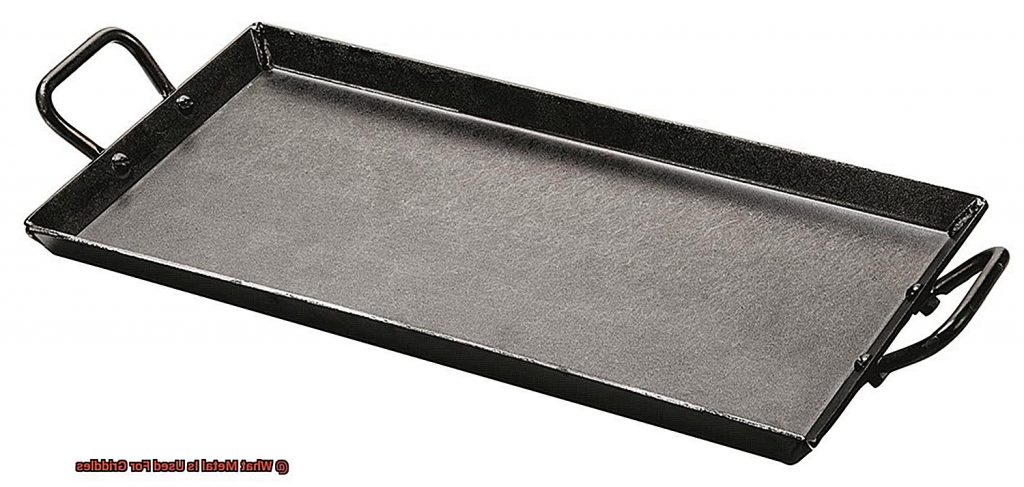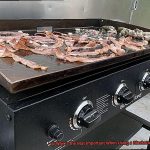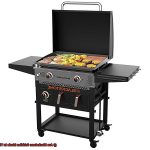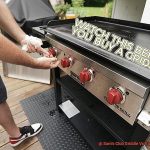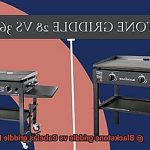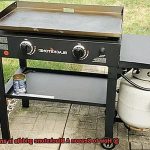Are you ready to cook up a storm in the kitchen?
Griddles are a great tool for making anything from pancakes and eggs to burgers and quesadillas. But what metal is used for griddles?
Surprisingly, not all griddles are made of cast iron. There are many types of metals that can be used to make a long-lasting griddle.
Each material has its own advantages and disadvantages. In this blog post, we’ll explore some of the most common metals used for griddles.
We’ll discuss their pros and cons, as well as how to choose the right material for your needs. Plus, we’ll give tips on how to care for your new griddle.
By the end, you’ll have all the info you need to make an informed decision about which type of metal is best suited for your cooking needs.
Contents
What is a Griddle?
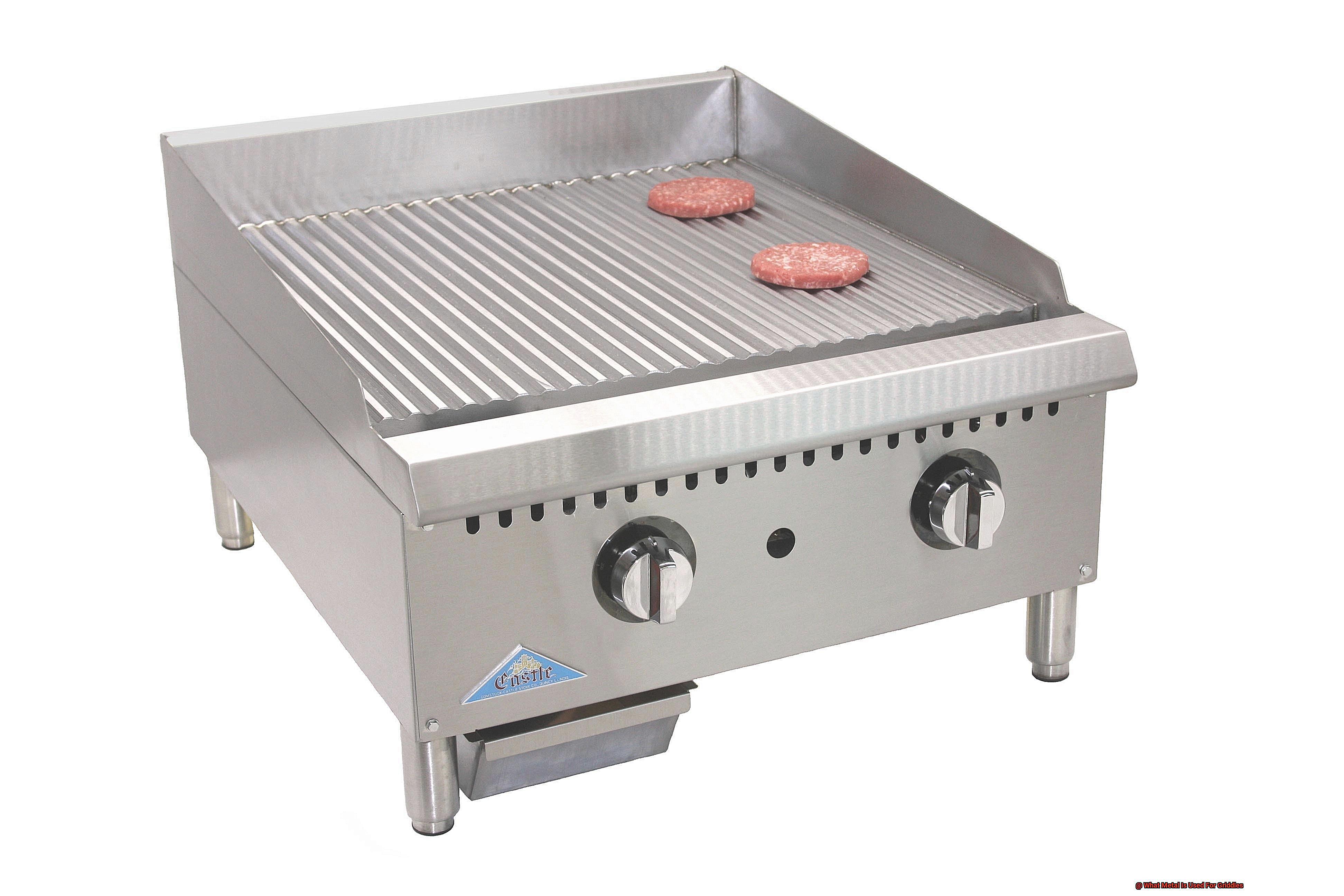
A griddle is an essential piece of cooking equipment for any kitchen.
Whether you’re making pancakes for breakfast, searing a steak for dinner, or barbecuing burgers and hot dogs, a griddle is the perfect tool to get the job done. But what type of metal makes the best griddle?
Cast iron is one of the top choices when it comes to griddles due to its excellent heat retention and distribution capabilities. This metal heats up slowly and gradually, making it ideal for cooking pancakes, eggs, burgers, and more.
Cast iron is also incredibly strong and easy to clean and maintain. Aluminum is another popular choice due to its affordability and lightweight construction.
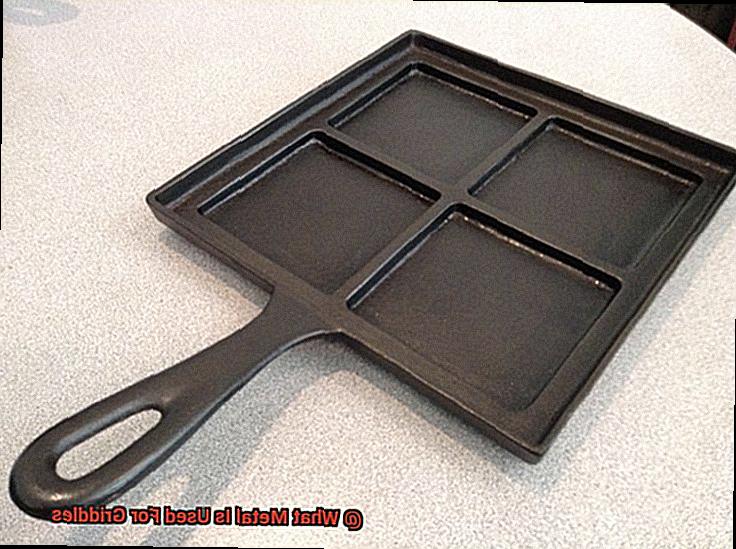
Aluminum heats up quickly and evenly, making it great for quick meals. However, aluminum can warp or scratch when exposed to high heat, so it may not be suitable for heavy-duty use.
Stainless steel offers durability and resistance to rust and corrosion that make it ideal for commercial-grade griddles. It also has a polished surface that is easy to clean, making it perfect for outdoor use in harsh weather conditions.
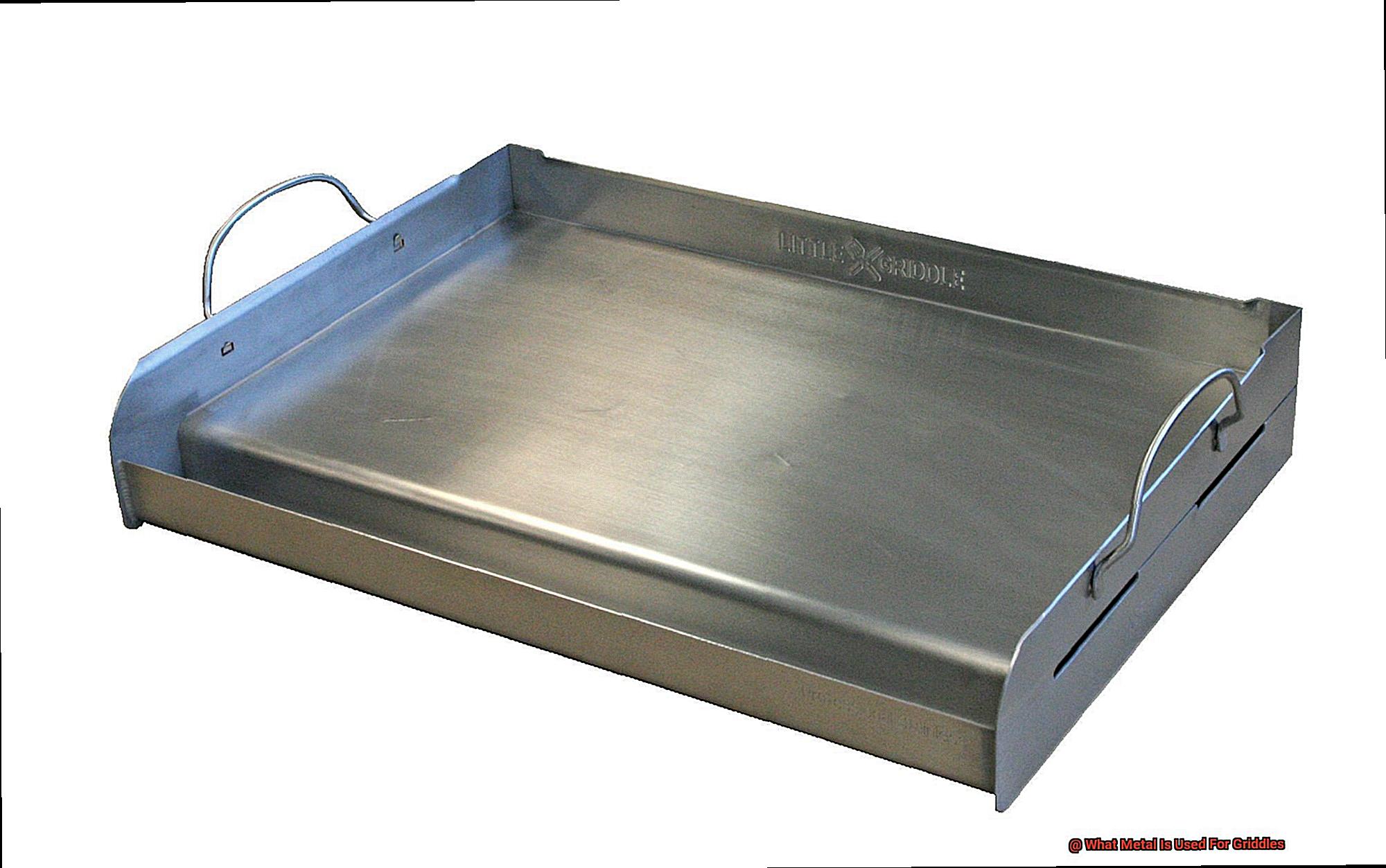
Finally, carbon steel is often overlooked but can also be a great choice due to its affordability, durability, and excellent heat retention abilities. To create a non-stick surface with a longer life span than other metals, carbon steel griddles must be treated prior to use.
Ultimately, the right metal for your griddle will depend on your cooking needs, budget, and personal preference.
Cast Iron Griddles
If you’re looking for the perfect cooking companion, cast iron griddles are the way to go.
This hardy metal has been used for centuries to prepare everything from pancakes to burgers, and its even heat distribution and superior heat retention make it a top choice. Not only are cast iron griddles free of harmful chemicals like PTFE and PFOA, which are often found in coated non-stick cookware, but they can also be used on a variety of heat sources such as gas, electric, induction cooktops, campfires, and grills.
Plus, ridges or grooves can help you create beautiful grill marks while allowing excess fat to drain away from your dish. When selecting a cast iron griddle, be sure to choose one that is thick and heavy in order to ensure even heat distribution.
Aluminum Griddles
For those in search of the perfect cooking companion, aluminum griddles are the ideal choice.
Not only are they lightweight, making them easy to move around in the kitchen, but they also offer unbeatable heat distribution and non-stick properties. Aluminum griddles are a popular pick for those looking for a cost-effective alternative that is simple to maintain and clean.
The anodized coating on these griddles creates a layer of oxidization which makes them non-reactive and safe for use when cooking. What’s more, their quick heating capabilities make them perfect for fast-paced tasks in the kitchen.
These griddles are incredibly versatile and robust enough to handle anything you throw at them – from pancakes and eggs to burgers and more. Plus, with their even heat distribution, you can guarantee your food will be cooked properly every time.
Stainless Steel Griddles
These reusable, non-stick wonders are perfect for creating culinary masterpieces. Whether you’re flipping pancakes or burgers, stainless steel griddles have unbeatable heat distribution and excellent corrosion resistance.
Plus, they’re easy to clean and maintain. What makes stainless steel griddles so great?
It all comes down to the grade of steel used. 304 and 430 are the most common grades used for griddles.
304 stainless steel is a higher quality grade with a higher nickel content, making it more resistant to rust and corrosion. This type of stainless steel is often used for high-end griddles and is ideal for cooking food that is acidic or contains a lot of salt.
430 stainless steel, on the other hand, is a lower quality grade that does not contain as much nickel but is also more affordable. This type of stainless steel is often used for lower-end griddles or commercial griddles that are replaced frequently.
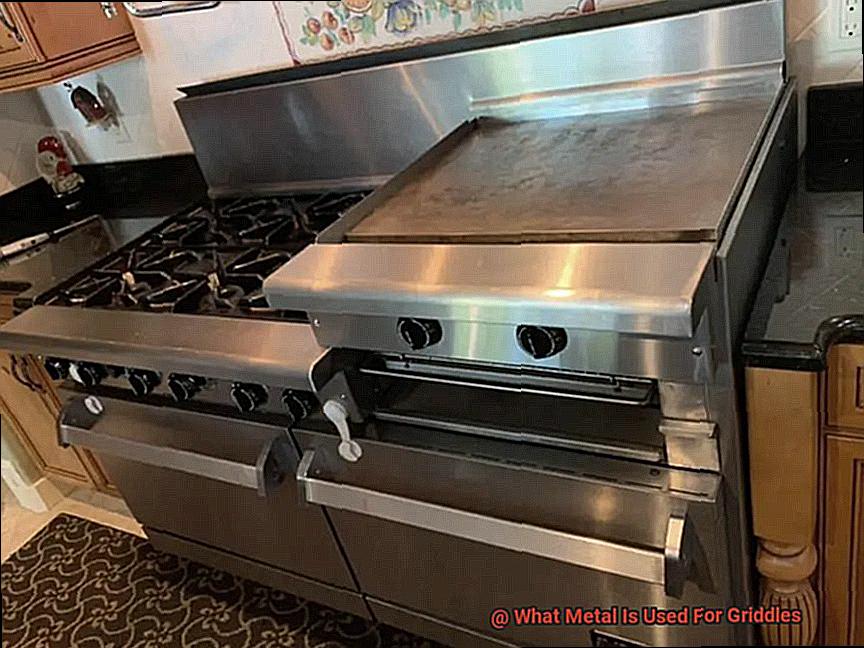
No matter what kind of stainless steel you choose, it’s important to take care when cleaning your griddle. Avoid using harsh chemicals or abrasive sponges that can scratch or damage the surface; instead use a gentle cleaner and soft cloth after each use to ensure your griddle lasts as long as possible.
Stainless steel griddles are an efficient and reliable kitchen companion.
Carbon Steel Griddles
If you’re in the market for a reliable and long-lasting griddle, carbon steel is an excellent option.
Not only is it durable and affordable, but it also has excellent heat retention properties that make it perfect for cooking a range of dishes such as pancakes, eggs, and bacon. It’s lightweight and easy to maneuver, making it ideal for large batches of food.
Plus, it can be used on gas or electric stovetops, as well as outdoor grills or campfires. When selecting a carbon steel griddle, be sure to choose one made from high-quality steel for the best results.
This will ensure greater resistance to warping and more even heat distribution. After use, cleaning is simple – just a quick hand wash and dry is all that’s needed.
Pros and Cons of Different Metals Used for Griddles
When it comes to griddles, the metal it is made of is essential for optimal performance, durability, and maintenance.
Different metals have their own unique properties that can make them more or less suitable for your needs. Here are some of the most common metals used for griddles and their advantages and disadvantages:
Stainless steel is a popular choice due to its robustness, ease of cleaning, and rust-resistance. This food-grade metal won’t affect the taste of your food, but it doesn’t offer the best heat retention capabilities.
Aluminum is a good conductor of heat and lightweight, but it may warp over time and is prone to scratches and dents. Cast iron has great heat retention properties and a naturally non-stick surface when seasoned properly.
However, it requires more frequent maintenance than other metals and can rust if not cared for correctly. It also takes longer to heat up or cool down.
Carbon steel is known for its durability and heat retention capabilities but must be seasoned before use to prevent rusting. Additionally, acidic foods may react with this metal, altering the taste of your food.
aBN7vLbbOEk” >
Tips for Choosing the Right Material for Your Griddle
Choosing the right material for your griddle is a critical decision that can have a major impact on the quality of your cooking. Whether you’re looking for a lightweight and affordable option or a professional-grade model, there are several materials to choose from. Here are some tips to help you make the right choice for your griddle:
Stainless Steel
Stainless steel is an attractive and durable material for griddles. It’s rust-resistant, making it ideal for outdoor use, and has a non-stick surface that makes cleaning easy. Look for stainless steel with a high nickel content, such as 304 or 316 grade, which will be more resistant to corrosion and rust.
Cast Iron
Cast iron griddles are known for their superior heat retention and even heating. They require seasoning before use, which can be time-consuming but also makes them non-stick and more durable over time. Cast iron is heavier than other materials but it is also very reliable.
Carbon Steel
Carbon steel griddles heat up quickly and evenly, making them great for cooking a wide range of foods. They are also relatively lightweight compared to cast iron, making them easier to handle. Carbon steel requires regular seasoning and maintenance in order to develop its natural nonstick surface over time.
Aluminum
Aluminum griddles are lightweight and affordable, heating up quickly and evenly to cook food fast. However, aluminum can be prone to warping or scratching over time when exposed to high temperatures so it may not be the best choice if you plan on using your griddle often or at high heat levels.
Also Read: Can Galvanized Sheet Metal be Used on a Cooking Grill?
Conclusion
Choosing the right metal for your griddle can be tricky.
Cast iron offers excellent heat retention and distribution, while aluminum is lightweight and cost-efficient. Stainless steel is rust-resistant and easy to clean, and carbon steel has amazing heat retention but requires regular seasoning.
Regardless of which metal you choose, it’s important to properly care for and maintain your griddle to ensure it lasts a long time and cooks up delicious dishes every time.

